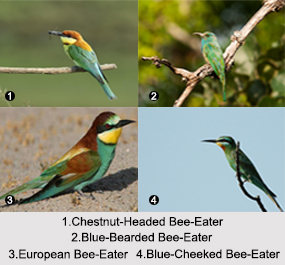 The Indian Subcontinent provides suitable habitats to various species of birds for residing and nesting. Bee-Eaters are no exception in this regard. They belong to the kingdom, Animalia; phylum, Chordata; class, Aves; order, Coraciiformes; and family Meropidae. These Bee-Eaters are described below.
The Indian Subcontinent provides suitable habitats to various species of birds for residing and nesting. Bee-Eaters are no exception in this regard. They belong to the kingdom, Animalia; phylum, Chordata; class, Aves; order, Coraciiformes; and family Meropidae. These Bee-Eaters are described below.
Chestnut-Headed Bee-Eater
Chestnut-Headed Bee-Eater is a resident breeder of the Indian subcontinent. As the name of the bird suggests, it has bright chestnut forehead, crown and nape. Its lower face is also bright chestnut in color. The sides of the face, chin and throat are yellow in color. The black colored lores extend as a band under the eye and ear-coverts. Its wing-coverts, primaries, secondaries, tertiaries and lower back are green in color. Rump and upper tail-coverts of the bird are pale shining blue in appearance.
Blue-Bearded Bee-Eater
Blue-Bearded Bee-Eater has grass-green upperparts and creamy yellow underparts. It has bluish green forehead, face and chin. It"s large and sickle shaped bill is gray with pale grayish yellow base. It has elongated, broad and blue throat feathers, which give it a bearded appearance when they are fluffed out. The color of the belly ranges from yellowish to olive with streaks of green or blue. The bird has square ended tail. The peninsular Indian populations are known to be paler green than the northeast Indian populations. Its subspecies N. a. athertoni is found in India.
European Bee-Eater
European Bee-Eater is a summer visitor of Kashmir and western Himalayas. The bird has brown and yellow upper parts. It has black colored beak. The wings of the bird are green and the two central tail feathers are elongated. The non-breeding bird can be identified in terms of a blue-green back. It is devoid of elongated central tail feathers and tends to be much duller in appearance. Although male and female eaters are similar, the female bird has greener rather than gold feathers on shoulders.
Asian Green Bee-Eater
Asian Green Bee-Eater is a small and slender bird. The dominant color on its body is green. The subspecies found in India are M. o. beludschicus, M. o. orientalis and M. o. ferrugeiceps. The nominate subspecies are known to be overall greenish birds. They have light rufous brown crown, nape and upper back. There is a fine black line extending from the base of the bill, through the eye and beyond it. Their chin and throat are greenish blue. They have greenish flight feathers, with rufous tinge. The central tail feathers of the birds prolong into blunt pins.
Other Indian Bee-Eaters
Blue-Cheeked Bee-Eater and Blue-Tailed Bee-Eater are the other two Bee-Eaters which have been traced in India.











